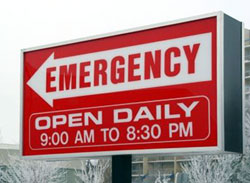
A recent survey of ED docs indicates that they believe that ED overcrowding is getting worse. From the Modern Healthcare story:
In a survey of nearly 1,500 practicing emergency physicians, more than 80% said crowded conditions in their emergency departments had increased either slightly (40.2%) or significantly (42.4%) in the past year, according to a recent poll from the American College of Emergency
Physicians. In the study, conducted from Aug. 28 to Sept. 19, nearly 67% of respondents cited "not enough staffing and/or resources" as their leading concern about patient care.Other top concerns included decreased throughput in the emergency department because of boarding patients (65.4%) and long wait times (65.3%). Also, 40.4% of physicians said their emergency-care environment has overcrowding and that access to specialty physicians and similar practice issues is a concern, but not yet a crisis.
Of those who responded, 703, or about 47%, said they had experienced a patient suffering as a result of crowded emergency rooms, while 200 said they had experienced a patient death for this reason at some point.
First off, while quantitative percentages are quoted extensively, this is really just a survey on the opinions of emergency room physicians. As noted a couple days ago, actual operational data is much harder to come by. Certainly the emotional assessment of front line physicians on ER overcrowding has value, but it is certainly not scientific.
Caveats out of the way, it is likely that ED overcrowding is indeed getting worse. Certainly there's no doubt emergency room volumes are increasing. The major cause of this overcrowding, "not enough staffing and/or resources," is frustratingly vague - but then the survey is based on opinion rather than operational data. Are they talking about staffing and resources in the ED, outside the ED in downstream areas, or both?
The survey hints rather strongly at both the causes and potential solutions to reduce overcrowding. Overcrowding due to boarding patients in the emergency department was noted as the second major cause. Boarding patients - parking them on gurneys in hallways while they await a "soon to be available" inpatient bed - results from down stream patient flow bottlenecks. Building a bigger ED won't help with that problem.
Another story, noted by FierceHealthcare, describes a 2006 study showing that increasing ICU beds reduces ambulance diversion and increases hospital revenue. The study, done at Oregon Health and Science University Hospital and published in the Annals of Emergency Medicine (abstract), includes some interesting data.
- Based on 10,301 adult ED patients in 2002 and 2003, the average hospital revenues per patient were $4,492
- Each hour spent on diversion cost the hospital $1,086 in lost revenue
- An increase of staffed ICU beds from 47 to 67 beds reduced time on diversion by 63%
- The hospital gained $175,000 in additional monthly revenues through reduced time on diversion
Since critical care and telemetry represent the most common patient flow bottlenecks that result in ED overcrowding and diverts, the outcome of this study is expected. You too can calculate the cost per hour of revenue lost due to emergency room diversions - to provide one more reason why those units that won't take your patients should buck up and start carrying their weight.
Solving your ambulance diversion problem by adding ICU beds is perhaps not the best approach (but it is by far the most expensive). OHSU is sort of ICU-crazy, with a 1:2 ratio of "special care" beds to med/surg beds (155 critical care beds to 311 med/surg beds). This compares with another Portland metro hospital, Providence St Vincent. At virtually the same number of beds (466 for OSHU, 450 for St V's) St Vincent as 7 critical care beds for every 54 med/surg bed (94 critical care beds to 356 med/surg beds).
Implementing variable acuity units at your hospital can go a great way to eliminating critical care patient flow bottlenecks. The capital cost to implement variable acuity units (or universal beds) is much lower than building more ICU beds. The rub is the management effort to retool the impacted nursing units and getting buy-in (and compliance) from your medical staff. But then, nothing is easy.
As an aside, using the American Hospital Directory (found in the Resources tab under Important Web Links), I created a spreadsheet that compares beds, LOS, total patient days, gross patient revenue, etc. While there are many differences between the hospitals, like LOS, it is interesting to note that St Vincent's revenue is 4 times the gross patient revenue at OHSU.
UPDATE: I tried to find an email address for the principal investigator, John McConnell, for the study I quote above, but was unsuccessful. If you know John, I'd love to chat with him about his study (not to mention all those ICU beds). Thanks!


Recent Comments